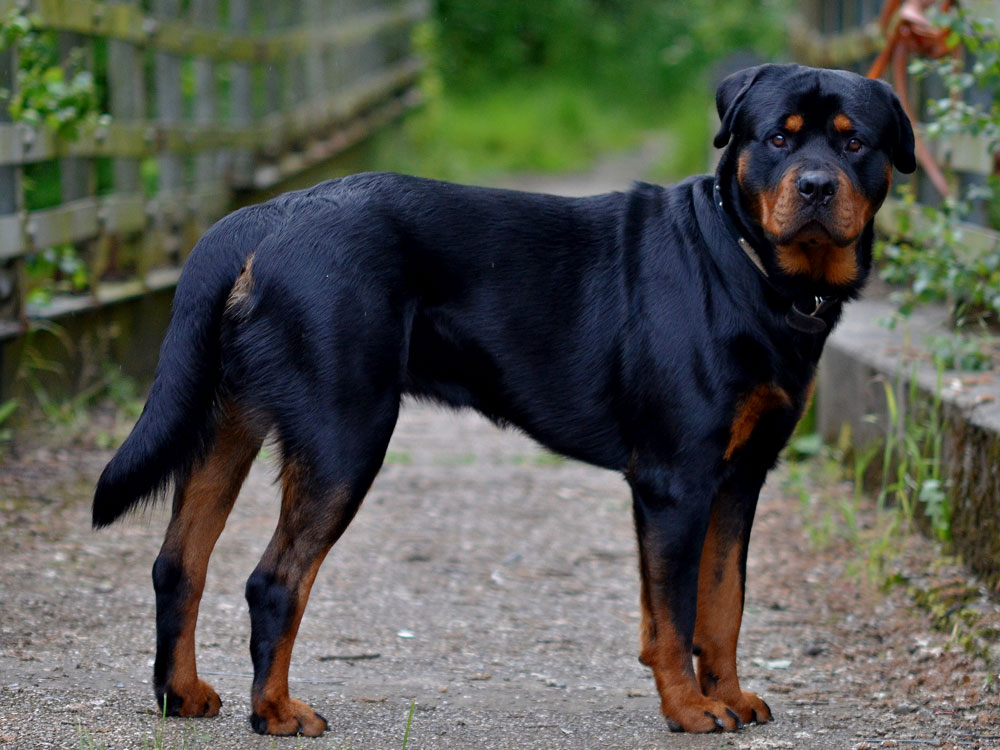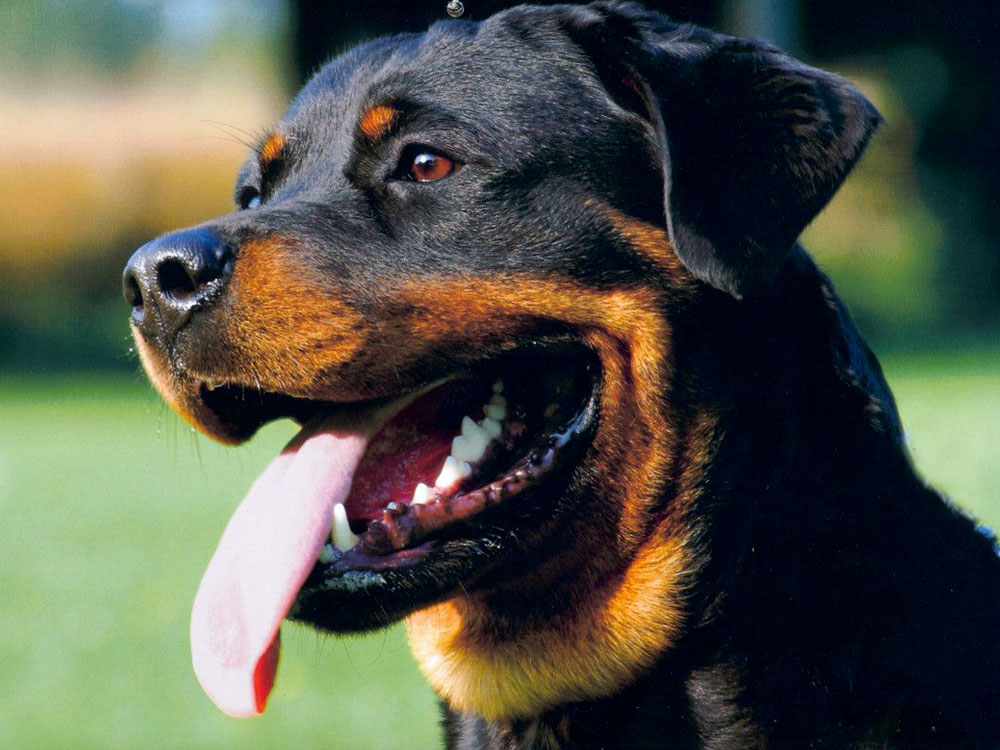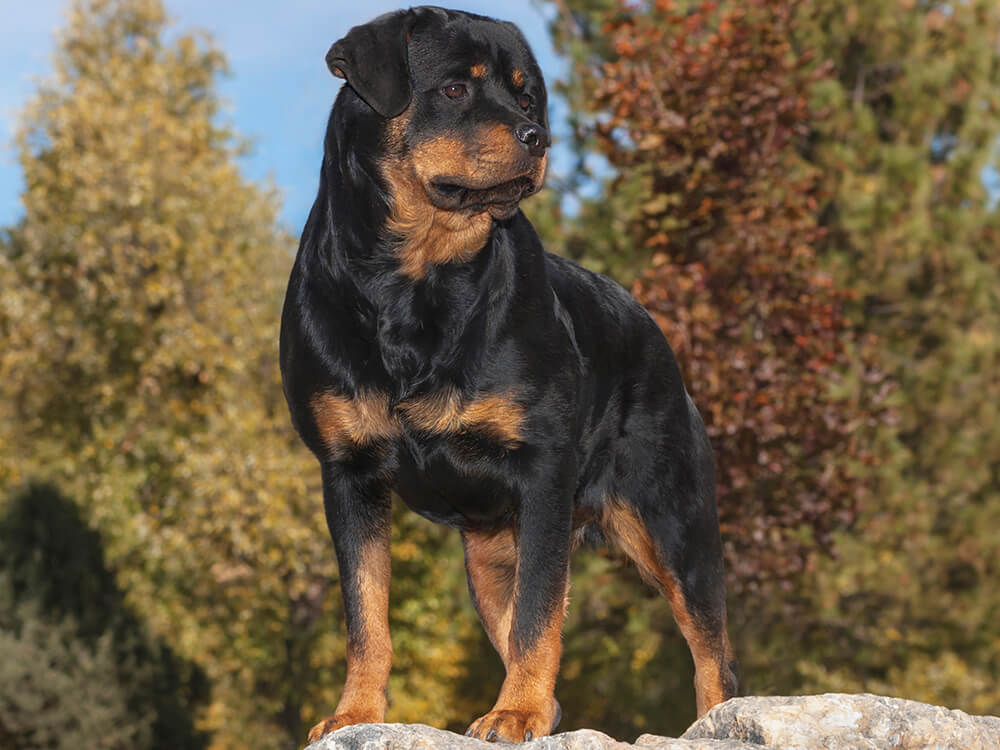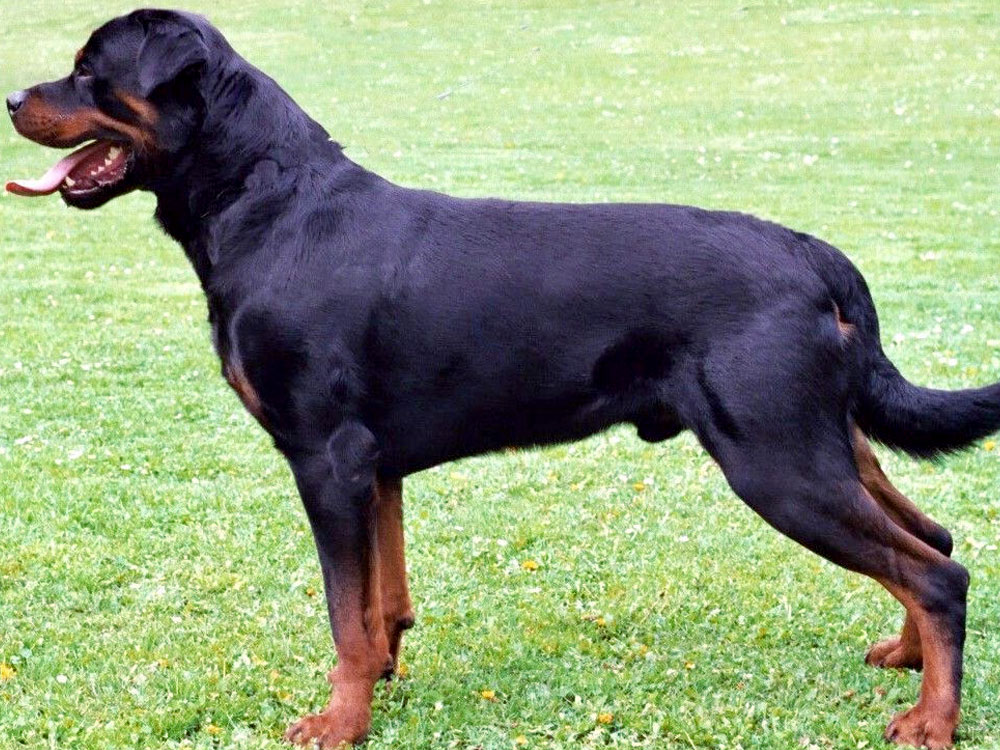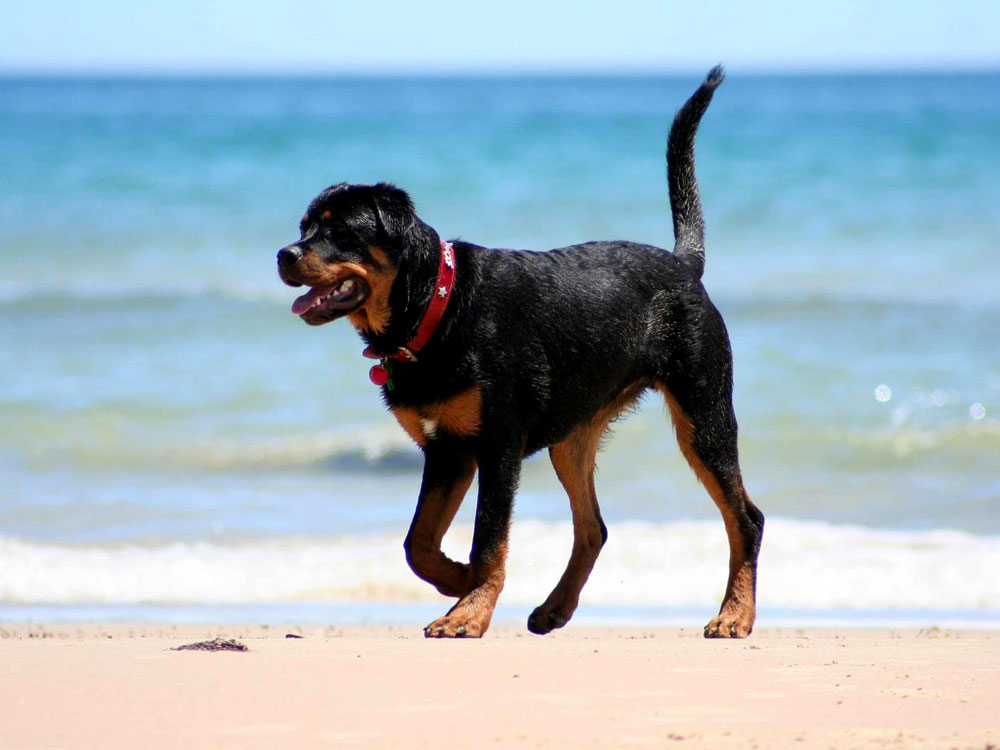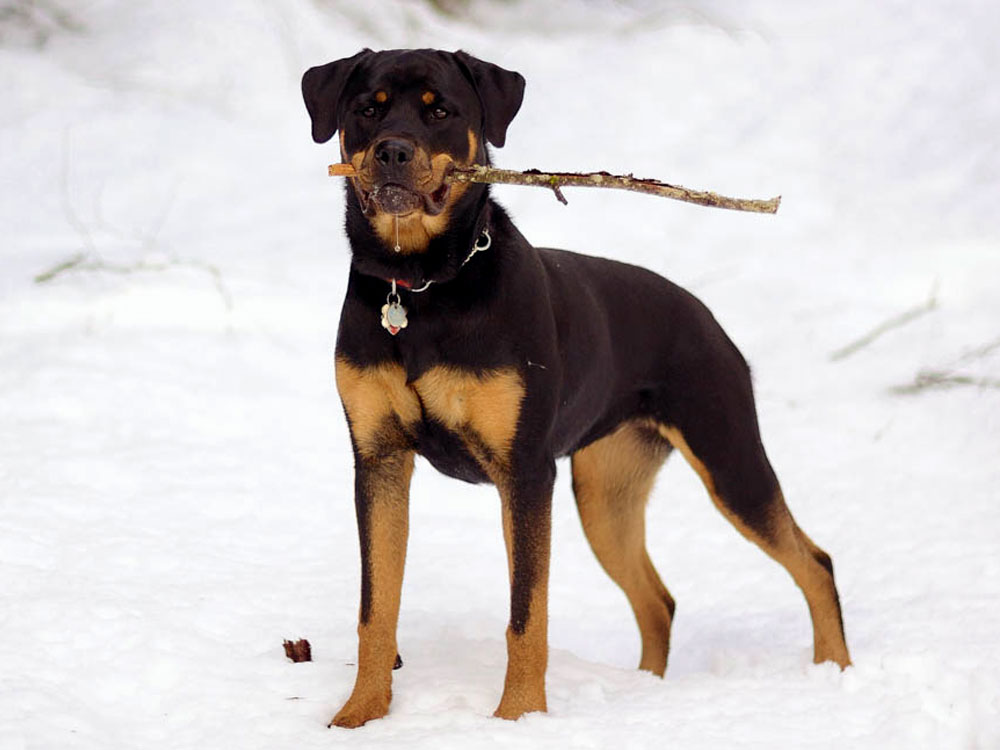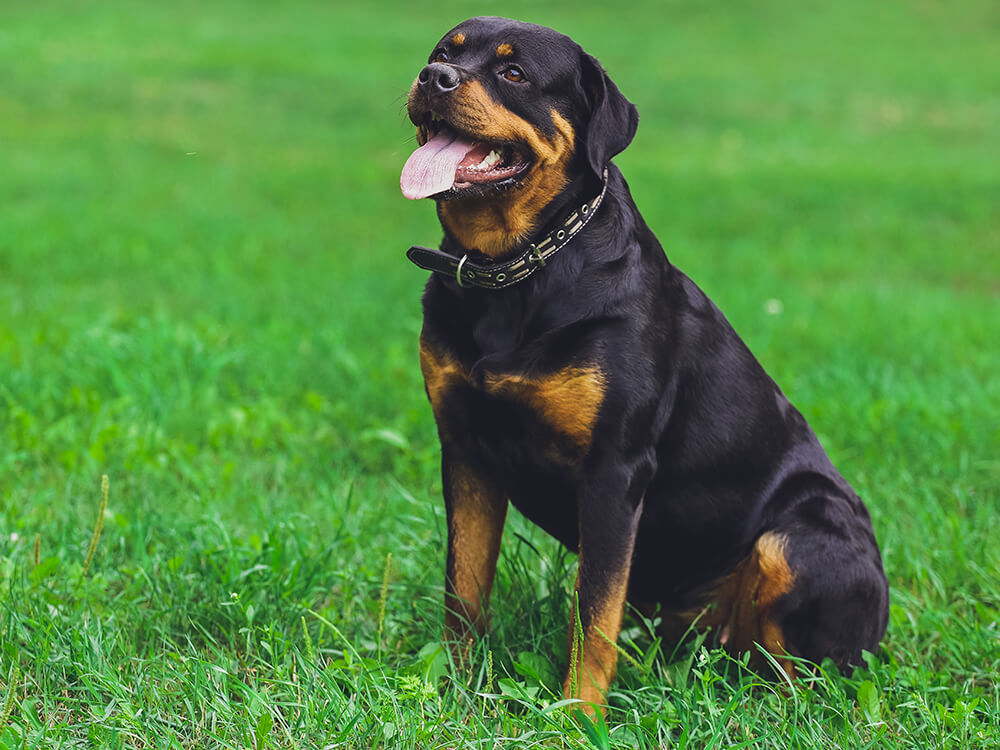
Rottweiler Breed Pictures
Vital Breed Stats
| Height: | 61 - 69 cm M | 56 - 63 cm F |
| Weight: | 43 - 59 kg M | 38 - 52 kg F |
| Breed Group: | Utility Dog Group |
| Life Expectancy: | 10 - 13 years |
| KC Registered: | No |
Breed Characteristics
| Size: |  |
| Grooming: |  |
| Exercise Level: |  |
| Trainability: |  |
| Barking Level: |  |
| Good with Children: |  |
| Good with other pets: |  |
| Affectionate: |  |
| Protective: |  |
| Cost to Keep: |  |
Give a thumbs up if you love the Rottweiler

0
More About the Breed
History
The earliest Rottweilers were believed to have come from Roman cattle dogs brought to Southern Germany. They were called Rottweiler Metzgerhund, which means Rottweil butchers’ dogs. The Rottweiler breed was brought to the UK in 1936 by Phil (Thelma) Gray. During the Second World War, the dogs were sent to Ireland for safekeeping but vanished after the war.
During the first post-war Rottweilers were imported to England in 1953 by Captain Roy Smith of the Royal Veterinary Corps. The Rottweiler was then registered as a breed by The Kennel Club in 1965.
Appearance
The Rottweiler is a large, robust, and powerful dog that weighs between 85 and 130 pounds and stands 55 to 68cm at the withers. The breed’s substantial build and massive frame indicate great strength, dexterity, and endurance. Rottie has a medium-length head and a broad skull between pendant ears. The chest is roomy and broad.
According to the Kennel Club (KC) breed standard, the Rottweiler should come in black with clearly defined tan markings. There is usually a spot on each eye and on the cheeks, and/or a strip around each side of the muzzle. White markings are considered undesirable.
Grooming
The Rottweiler’s medium-length outer coat is straight, coarse, and lies flat. The undercoat is noticeable on the neck and thighs. Rottie has a relatively easy-to-maintain coat that requires weekly brushing and regular bathing. The Rottweiler sheds moderately throughout the year, except in the spring and fall where copious amounts of shedding are to be expected.
Rotties' nails need to be trimmed weekly. Ensure that their ears are clean and the skin is free of ticks and fleas.
Never overlook your Rottie's dental health as tooth decay and gum disease can cause various illnesses. Start training to brush your Rottweiler puppy's teeth at an early stage so he gets used to this process. Teeth should be brushed weekly, daily if possible. Provide your Rottie with appropriate chew toys to keep the jaw strong and the teeth clean by reducing plaque buildup.
Temperament
Are Rottweilers Dangerous?
The Rottweiler, which belongs to the working dog group, is typically a calm, confident, and good-natured dog. He’s not vicious nor aggressive but possesses a guard dog natural instinct which explains the innate desire to protect the home and family.With a wait-and-see attitude towards different situations in the environment, the Rottweiler remains calm and responds quietly. Rotties can be aloof towards strangers and it takes time before warming up to guests.
Intelligence
Rotties are intelligent, adaptable and hardworking. Male Rotties are more quiet and vigilant, whilst female Rotties are more manageable and warm. Realistically, training a Rottweiler can be quite challenging as it requires time, patience and assertiveness. When leadership is established, the training will be much easier.
The Rottweiler loves children especially if they grow up together. However, since a Rottweiler is a large strong dog, every interaction should be supervised as it can accidentally trample a small child. This breed is best suited for families with older children who understand how to properly interact with dogs. They thrive as guarding and police dogs.
Nutrition
Typical calorie needs of an adult Rottweiler, weighing 110 pounds, per day:
- Senior and less active: up to 2,000 calories daily
- Typical adults: up to 2,200 calories daily
- Physically active/working dogs: up to 2,700 calories daily
Choose a high-quality brand that lists animal protein (beef, bison, chicken, or turkey) as its main ingredient. Wheat, corn and other glutens should be avoided as they are prolific skin and digestive allergens for this breed. Carbohydrates should be from vegetables like sweet potato and carrots.
Since the Rotties are prone to hip and elbow dysplasia, Rottweiler puppies should be fed a diet high in glucosamine and chondroitin which are natural substances that protect the joints. Omega fatty acids from fish would help maintain a healthy coat.
Feeding
Health
How long do Rottweilers live?
Rottweilers' average lifespan is 8-12 years. Rotties are generally healthy but are predisposed to certain health conditions, including Hip and Elbow Dysplasia, Panosteitis, Osteosarcoma, Aortic Stenosis/sub-aortic stenosis, and Hypothyroidism. They are also prone to allergies and bloating.Exercise
The Rottweiler is an active dog that loves a lot of exercises; a minimum of 2 hours a day. This is not only to maintain a healthy body but also to avoid destructive behaviours as a result of lack of exercise.
The type of physical activities should depend on the energy level of your Rottie. Aside from free time at a fenced yard, introduce structured exercise regimens that would develop their athleticism, obedience and agility.
Cost of Ownership
The Rottweiler costs anywhere from £600 to £1,000. Expect to pay a little more for a well-bred pedigree Rottweiler puppy from a KC-registered reputable breeder. On top of this, expenses for dog supplies and equipment like crates, beds, bowls, leashes, collars, and toys can set you back £200.
As a large dog with a big appetite, the budget for high-quality food for your Rottweiler can go as high as £80 a month. As with other breeds, you also have to factor in neutering, annual veterinary immunisations, deworming/flea treatments, and health checks, which can add up to more than £1000 per year.
The cost of caring for a Rottweiler is estimated between £140 and £210 a month, depending on the type of insurance you get (£60/month for the basic package or £130/month for a lifetime package). Keep in mind that this estimate does not include costs of unforeseen ailments that would require treatments that are not covered by insurance.
Rottweiler Breed Highlights
- The Rottweiler is intelligent but can be challenging to train if owners do not establish the alpha role.
- The Rottweiler is an extremely loyal and protective dog.
- The Rottie is not for first-time dog owners, a calm assertive experienced owner is required.
- It needs early socialisation and proper training to understand that people outside of the household don’t necessarily mean any harm.
- The Rottweiler has low grooming needs.
- This large breed is active and has high exercise requirements.






